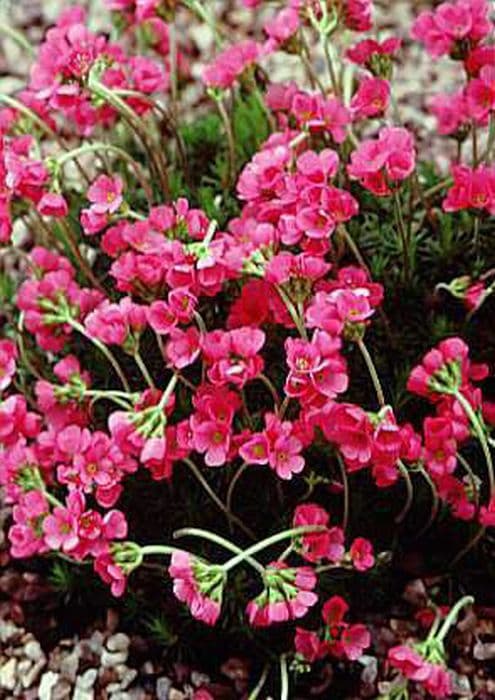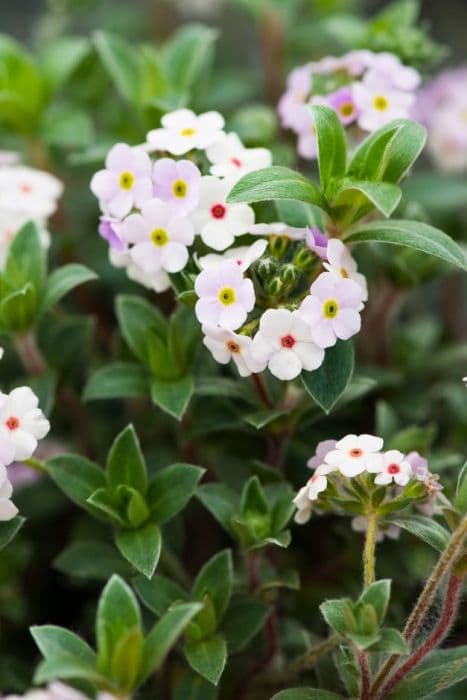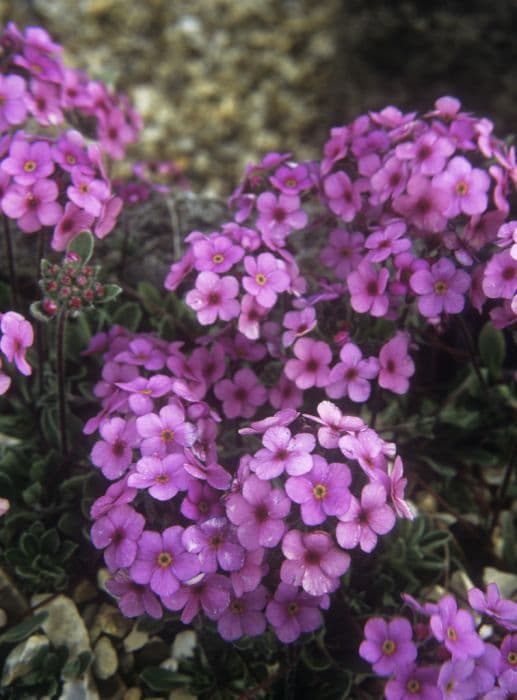Primrose Primula 'Wharfedale Gem' (allionii hybrid) (Au)

ABOUT
Primula 'Wharfedale Gem', an allionii hybrid, showcases a delightful appearance. This vibrant perennial features dense rosettes of mid-green, spoon-shaped leaves that provide a lush backdrop for its striking flowers. The blooms emerge on short stems, held just above the foliage, and are noted for their charming, colorful display. Each flower typically boasts a round shape with a delicate, ruffled edge, presenting a quaint yet ornamental aspect. The petals radiate from a central eye, often in a contrasting hue, which adds depth and detail to the plant's overall aesthetic. The bloom's color palette ranges from soft pastels to intense shades, which can create a vivid splash of color in a garden setting. The floral display of Primula 'Wharfedale Gem' is a true herald of spring, as it typically flowers during this season, and it continues to be an alluring feature in gardens that seek to evoke a sense of enchantment and natural beauty.
About this plant
 Names
NamesFamily
Primulaceae.
Synonyms
Primrose, Auricula Primula.
Common names
Primula x allionii 'Wharfedale Gem'.
 Toxicity
ToxicityTo humans
Primula 'Wharfedale Gem', commonly referred to as polyanthus, is not considered highly toxic to humans. However, it is important to note that some people may experience mild discomfort if they ingest parts of the plant or if they have sensitive skin that comes into contact with its sap. Ingesting the plant may potentially lead to symptoms such as nausea, vomiting, or diarrhea. If the sap comes into contact with skin, it could cause irritation or a rash, especially in individuals with sensitive skin or those with allergies to the plant. As with any plant, it is advisable to wash hands after handling it and to keep it away from children who might inadvertently ingest it.
To pets
Polyanthus is not known to be highly toxic to pets, but it may cause mild gastrointestinal upset if ingested. Symptoms of poisoning in pets might include vomiting, diarrhea, and drooling. As with humans, the sap of the plant can potentially cause skin irritation if a pet comes into contact with it, especially if the pet has sensitive skin. It is always best to prevent pets from eating decorative plants and to monitor them around plants known to cause a reaction. If you suspect your pet has ingested any part of a polyanthus plant and is showing symptoms of distress, consult a veterinarian.
 Characteristics
CharacteristicsLife cycle
Perennials
Foliage type
Evergreen
Color of leaves
Green
Flower color
Pink
Height
6 inches (15 cm)
Spread
6 inches (15 cm)
Plant type
Herb
Hardiness zones
5
Native area
Europe
Benefits
 General Benefits
General Benefits- Ornamental Appeal: Displaying vibrant colors and an attractive rosette of leaves, it enhances the visual appeal of gardens and landscapes.
- Compact Size: Its small stature makes it suitable for rock gardens, borders, and small spaces.
- Spring Bloomer: Blooms in early spring, providing one of the first splashes of color after winter.
- Attracts Pollinators: Flowers attract bees and butterflies, promoting pollination in the garden.
- Low Maintenance: Requires minimal care once established, making it suitable for novice gardeners.
- Cold Tolerance: Hardy in various climates and can withstand cold temperatures.
- Variety of Uses: Can be used in container gardening, alpine troughs, and as ground cover.
- Long Blooming Period: Often has a lengthy blooming period from late winter to early summer.
 Medical Properties
Medical PropertiesThis plant is not used for medical purposes.
 Air-purifying Qualities
Air-purifying QualitiesThis plant is not specifically known for air purifying qualities.
 Other Uses
Other Uses- The leaves of Primula can be used as a natural dye for fabrics, giving a range of colors from green to yellow and brown depending on the mordant used.
- Pressed Primula flowers can be incorporated into candles to add a unique botanical element and subtle natural fragrance.
- Primula petals can be crystalized with egg whites and sugar to create edible decorations for desserts.
- The flowers are sometimes used in potpourri for their color and delicate fragrance, adding a touch of spring to your home.
- Primula can be used in mixed flower arrangements as they provide a pop of color and have a relatively long vase life.
- Dried Primula flowers can be used to make natural bookmarks, being pressed and laminated as a craft project.
- When hosting a garden party, frozen Primula blooms inside ice cubes can be an elegant addition to drinks.
- Primula leaves can be used in a garden compost pile, contributing to the nutrient content for soil enhancement.
- Petals of the Primula can be scattered on the surface of a pond or a bowl of water for a decorative floating floral display.
- They can be used as subtle highlights in handmade paper, providing an organic texture and touch of color to the paper.
Interesting Facts
 Feng Shui
Feng ShuiPrimrose is not used in Feng Shui practice.
 Zodiac Sign Compitability
Zodiac Sign CompitabilityPrimrose is not used in astrology practice.
 Plant Symbolism
Plant Symbolism- Hope: Similar to other members of the Primrose family, the Primula, often symbolizes hope, likely due to its early spring blooming, suggesting the return of life after winter.
- Youth: The delicate and vibrant blossoms of the Primula evoke feelings of youthfulness and the freshness of spring.
- New Beginnings: As one of the first flowers to bloom in spring, the Primula represents new beginnings and the start of a new cycle of life.
- Happiness: With its bright and cheerful flowers, the Primula is often associated with joy and happiness.
 Water
WaterFor best results, water Primula 'Wharfedale Gem', commonly known as Auricula, thoroughly but infrequently, allowing the soil to dry out slightly between waterings. In general, this might translate to about 1 inch of water per week, depending on climate and soil conditions. Use room temperature water directly on the soil, avoiding the leaves to prevent fungal diseases. During the active growing season in spring and autumn, you may need to increase the frequency of watering. In winter, when the plant is dormant, reduce watering to prevent root rot.
 Light
LightAuriculas require bright, indirect light or partial shade, avoiding the harsh afternoon sun which can scorch their leaves. A north-facing window or a spot that gets morning light and afternoon shade would be ideal. If grown outside, dappled light beneath high trees or a location with sunlight in the morning and protection from strong sun in the afternoon would be perfect.
 Temperature
TemperatureAuriculas thrive in cooler conditions and should be protected from extreme temperatures. The ideal temperature range for Auriculas is between 50°F and 70°F. They can survive brief dips down to freezing but prolonged exposure to temperatures below 32°F or above 80°F could be harmful to the plant.
 Pruning
PruningAuriculas benefit from deadheading spent flowers to encourage new blooms and maintain a neat appearance. After blooming is finished, typically in late spring or summer, trim off any dead or yellowing leaves. Pruning is usually done annually and is best performed immediately after the flowering period.
 Cleaning
CleaningAs needed
 Soil
SoilThe Polyanthus primrose, or Primula 'Wharfedale Gem', thrives best in a well-draining soil mix that is rich in organic matter. A good recipe for this plant's soil would be a mixture of peat, loam, and perlite or sand at equal parts to ensure proper drainage and aeration. The soil pH should be slightly acidic to neutral, ranging from 6.0 to 7.0.
 Repotting
RepottingPolyanthus primrose should be repotted every one to two years to refresh the soil and accommodate root growth. It's best to repot in the early spring, just before the new growth starts, or in the fall after flowering has finished.
 Humidity & Misting
Humidity & MistingPolyanthus primrose prefers a humidity level between 50-60%, which is often the average indoor range. To ensure its health, it's important to maintain consistent humidity but avoid excessively damp environments that could lead to fungal issues.
 Suitable locations
Suitable locationsIndoor
Place in bright, indirect light and keep soil moist.
Outdoor
Plant in partial shade, protect from harsh sun.
Hardiness zone
5-9 USDA
 Life cycle
Life cyclePrimula 'Wharfedale Gem', commonly referred to as a type of Primrose, begins its life cycle as a seed which, when sown in fertile, well-draining soil and in cooler temperatures, will germinate to produce small rosettes of leaves. As the plant matures, it develops a stronger root system and foliage, while remaining a relatively low-growing perennial. In early spring to late spring, it produces clusters of distinct bell-shaped flowers, often in shades of yellow, pink, or purple, which attract pollinators and can lead to seed formation if fertilized. After flowering, the plant sets seed, which can be collected or allowed to self-sow. Throughout the summer, the foliage persists, and the plant may enter a period of dormancy during hot weather, especially if not kept moist. Primula 'Wharfedale Gem' completes its cycle by dying back in late autumn and winter, with the root stock surviving underground to generate new growth the following spring.
 Propogation
PropogationPropogation time
Spring-Early Summer
Propogation: For Primula 'Wharfedale Gem', a popular allionii hybrid, the most favored method of propagation is by division. This is typically done in late winter or early spring, just before the plant begins its active growth. To propagate by division, carefully lift the entire plant from the ground using a garden fork, aiming to keep the root ball intact. Gently tease apart the clumps into smaller sections, ensuring that each section has a part of the root system and a few leaves. Then, replant the divisions at the same depth they were previously growing, spacing them about 6 to 8 inches (approximately 15 to 20 centimeters) apart, and water them thoroughly to help establish the new plants.









